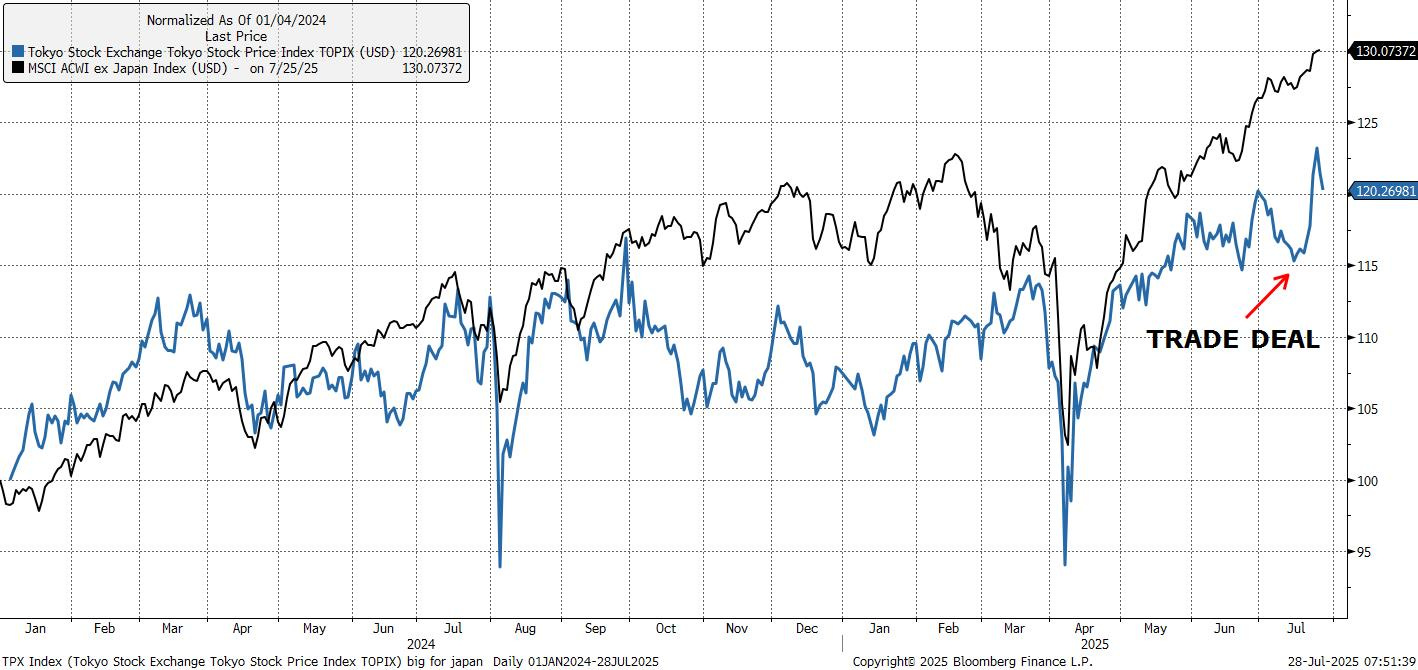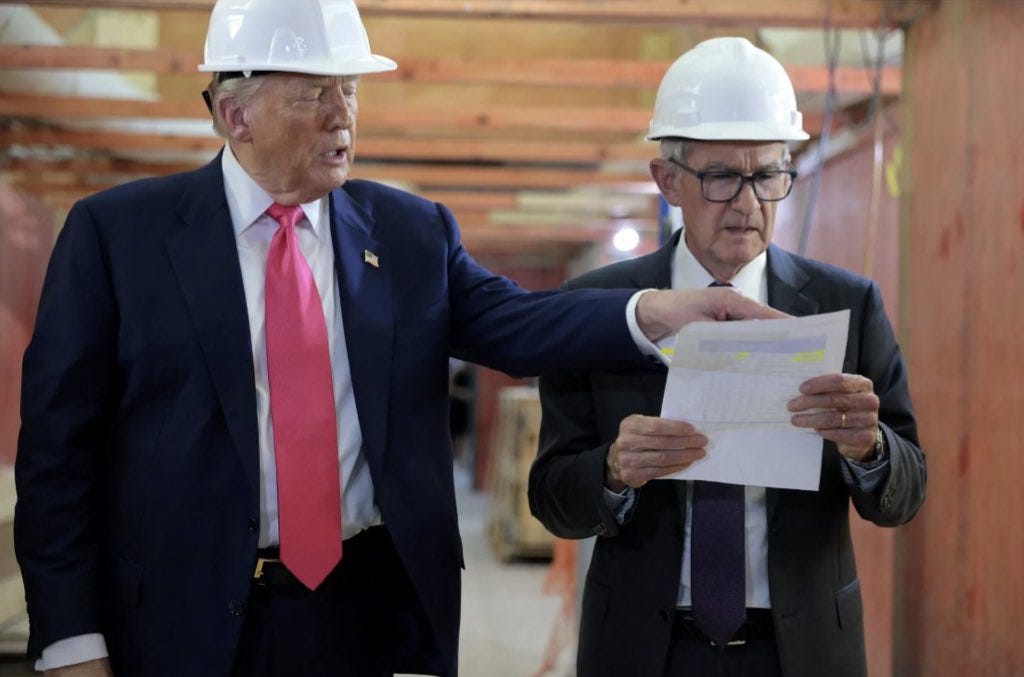Top Trade Ideas - July 28th
It's a deal.
US equities extended their summer rally with the S&P 500 closing at a record every single day last week, a feat not seen since 2021. The index is now up 11% from the tariff-induced lows in April, fueled by strong earnings, softer macro data, and a calmer Federal Reserve narrative. Nearly 82% of S&P companies that have reported so far have beaten estimates, on track for the best earnings season surprise rate since Q3 2021.
Under the hood, the risk-on tone remained intact, with industrials and materials joining the move higher, signalling some added breadth. That said, some rotation away from tech was visible, particularly as investors braced for next week’s Mag Seven earnings, which will test the staying power of AI enthusiasm amid rising tariff costs and softening consumer sentiment.
Meme stock flare-ups and soaring retail activity added a speculative sheen to the rally. But not everyone’s buying it. Bank of America flagged bubble risks, citing looser monetary policy and relaxed financial regulation as key ingredients for froth.
S&P 500 +1.5%, Dow Jones +1.3%, Nasdaq 100 +0.9%
Outperformers: Health Care (+3.4%), Industrials (+2.3%), Materials (+2.3%)
Laggards: Consumer Staples (+0.0%), Tech (+0.7%), Utilities (+0.9%)
It was a quiet week for Fed speakers due to the pre-FOMC blackout, but markets found reassurance in Powell’s remarks at a regulatory conference where he emphasised financial system stability. Earlier in the week, Trump walked back threats to fire Powell, helping soothe long-end rate volatility.
Jobless claims fell for a sixth straight week to 217,000—the longest streak of declines since 2022. Durable goods orders fell 9.3% in June (vs. -10.7% est), reflecting expected softness in transportation-related spending post-tariff disruptions. Rates market now prices ~60% chance of a September cut, with July viewed as a hold.
Trade headlines stayed front and centre. President Trump inked a deal with Japan, locking in a 15% tariff on autos while announcing a $550bn US investment fund. The agreement staved off the previously threatened 25% rate and included major Japanese commitments to Boeing, agriculture, and defence purchases.
A quick note on a few earnings… The bar was high and reactions mixed, with multiple bellwethers reminding markets that tariff friction and AI spending are beginning to bite:
Alphabet beat on revenue but raised capex guidance sharply to $85bn, spooking some. Still, AI-related sales momentum held up.
Tesla slumped 8.2% after Musk warned of “a few rough quarters” ahead. The EV giant continues to face fallout from Trump’s tax bill and declining regulatory credit revenue.
Intel plunged 8.5% after its CEO signalled cost cuts and capex pullbacks, raising questions over the viability of its turnaround strategy.
The 10-year Treasury yield fell ~3bps to hold around 4.85%, while 2s10s flattened 8bps. Strong demand at the 20-year auction and fading Powell concerns underpinned long-end buying.
The Bloomberg Dollar Index fell 0.6%, reversing two weeks of gains. EUR/GBP rose to the highest since 2023 after the ECB pushed back on further rate cuts, surprising markets with a more hawkish tone.
And this happened… which looked more like an SNL sketch than a public appearance between the President and his Federal Reserve chairman:
The Economic Week Ahead
A busy week lies ahead, with the most significant event being the Fed’s rate decision. We believe this meeting will be a non-event, with rates left on hold and quantitative tightening likely remaining unchanged (Treasury funding estimates are Monday, and the refunding announcement is Wednesday).
Trump’s August 1 tariff deadline is also on the cards for the few countries that have not negotiated trade deals, and a slate of key US data (payrolls, GDP, and inflation) is in focus. Yes, a lot on the US front this week.
In Japan, the BOJ is expected to maintain its policy rate at 0.5% when its two-day meeting concludes on Thursday, while in Canada, interest rates are expected to remain on hold at 2.75%. While a trade deal between the US and Japan reduced some economic uncertainty, policymakers will likely adopt a wait-and-see approach to the impact of tariffs.
The eurozone releases growth and inflation figures, with the first estimate of second-quarter gross domestic product on Wednesday and provisional inflation figures for July on Friday.
In China, policymakers are expected to convene for a key economic planning meeting before the end of the month.
On the earnings front, it’s a big week for the Magnificent Seven, as four of the remaining five to report results take centre stage. Amazon (Thursday), Apple (Thursday), Meta (Wednesday), and Microsoft (Wednesday) have all played a crucial part in the return to the win column for US equities since the tariff-driven slump in April.
US-EU Deal
It makes sense to start with the biggest news from the weekend: The US have a deal with the EU. The bloc accepted 15% levies on most imports to America and also agreed to purchase $750bn in energy from the US, to invest $600bn in unspecified ways that it would not have done previously, and to buy American arms.
Europe doesn’t benefit from this deal at all, but markets love it. Tariff uncertainty is now behind us, and Europe has fallen well below the 30% figure mentioned last week. A few thoughts about market reaction for the week ahead:
With a big source of uncertainty lifted, European investors are likely to follow a similar playbook to what we saw in Japan last week: rotation out of bonds and back into equities. That trend was already tentatively underway, but the removal of tariff tail risk gives it a green light. Expect flows into broad benchmarks and domestic-facing sectors, with particular support for cyclicals that had been discounted on the assumption of prolonged trade headwinds.
US defence names will continue to see tailwinds. While most sectors were only marginally affected by the weekend deal, defence was one of the few explicitly mentioned. The EU’s agreement to increase purchases of American arms creates durable upside for the space, especially given that political risk in Europe and the Middle East already had investor attention here. This reinforces a longer-term trend.
Small caps are also set up for some short-term outperformance. The tariff cloud has lifted, and the uncertainty discount is gone. With the final numbers now known and lower than the market feared, business outlooks can reset. That’s especially important for smaller firms with limited pricing power and tighter supply chains. The end of the ordeal matters more for them than for the global megacaps. However, through the end of the year, we still favour large caps as earnings revisions continue to accelerate and long-term yields stay high. Those headwinds can prevent longer-term outperformance for small caps.
FX
Cautious About Yen Vol:
In the week following the Japanese Upper House elections, uncertainty has increased, but it is not immediately apparent from the JPY price action.
With PM Ishiba in a tricky spot and a parliamentary gridlock, it’s somewhat surprising that interest rate expectations for a hike through to year-end have actually increased.




